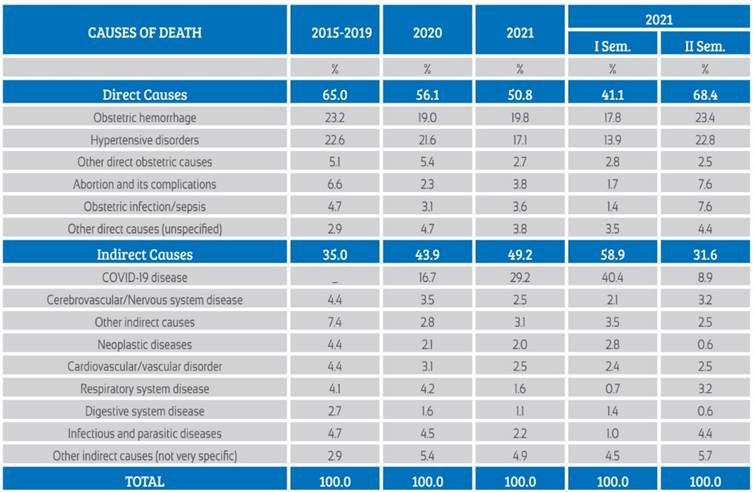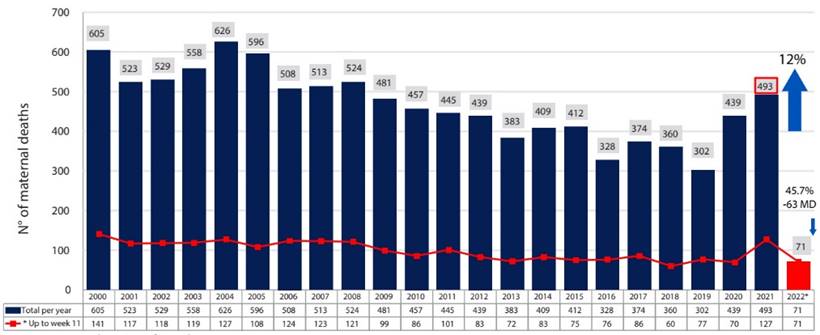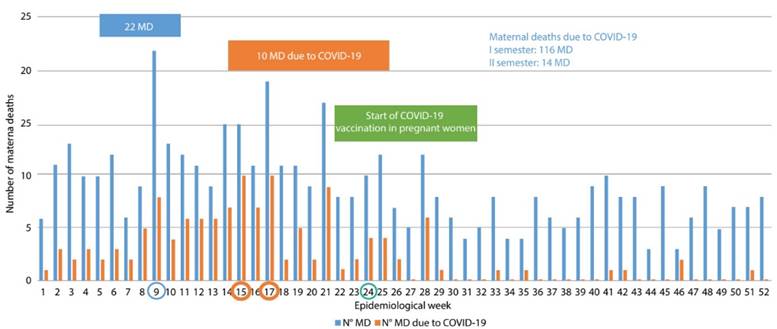Servicios Personalizados
Revista
Articulo
Indicadores
-
 Citado por SciELO
Citado por SciELO
Links relacionados
-
 Similares en
SciELO
Similares en
SciELO
Compartir
Revista Peruana de Ginecología y Obstetricia
versión On-line ISSN 2304-5132
Rev. peru. ginecol. obstet. vol.68 no.1 Lima ene./mar. 2022 Epub 24-Feb-2022
http://dx.doi.org/10.31403/rpgo.v68i2407
Letters to the Editors
Maternal mortality, changing causality in 2021?
Dear Editor:
We know that the absolute number of maternal deaths that occur each year in the world, compared to those that occur in traffic accidents, are very few. However, for a country, maternal mortality is a key indicator of development, and the level and quality of care provided to women before, during and after pregnancy, inside and outside the health system, reflects the relative value that each society places on them1. For this reason, this indicator is very important to compare the efforts that each country is making from the health point of view.
Maternal mortality, which had decreased in recent years from the figures we used to have of more than half a million maternal deaths worldwide each year (543,000) to 287,000 per year2, has increased in the last two years because of the COVID 19 pandemic, especially in countries where health systems were not prepared to deal with it. According to United Nations (UN) estimates, ‘up to 20 million women in the Americas will have their birth control interrupted during the pandemic, either because services are not available or because women will no longer have the means to pay for contraception’3.
Peru has not been absent from this situation, and all the efforts made to reduce the number of maternal deaths each year have collapsed because of the pandemic. In 2020, unfortunately, not only did it not decrease, but it increased by 47.1% with respect to the previous year, reaching figures like those of 2012. In total there were 439 maternal deaths, and of these the main cause was preeclampsia, the second was hemorrhage and the third cause was COVID-19. The latter was the leading cause of indirect maternal deaths 4.
In 2021, the situation has not been different and, according to the latest information from the CDC of MINSA(5), there have been 493 maternal deaths due to direct and indirect causes; that is, 12% more than in 2020, not counting late maternal deaths (Figure 1).
It is noteworthy that, in relation to the causes of direct maternal deaths compared to indirect maternal deaths, they are almost the same for the year 2021, with direct deaths being 46.9% and indirect deaths 46.7%. Incidental maternal deaths were 4%.
For the year 2021, the first cause of maternal death was COVID 19 (29.2%), the second cause was obstetric hemorrhage (19.8%) and the third cause was hypertensive disorders (17.1%) (Table 1). However, the analysis of what happened in the semesters clarifies the situation of maternal death in Peru in 2021, not only in its specific cause, but also in the differences between the percentages of direct and indirect causes.
Table 1 Maternal death by cause of death, 2015 - 2021.

Source: National Center for Epidemiology, Disease Prevention and Control - MINSA. *Up to week 52 of the year 2021, preliminary database (updated to January 04, 2022). Valid data available from epidemiological investigation and immediate notification as of 07/01/2022. N = 445 Deaths reported as direct and indirect, occurring up to 42 days after the end of gestation, were considered. COVID-19: Maternal deaths notified to the epidemiological surveillance system as deaths due to confirmed or suspected COVID-19.
In the first semester of 2021, 58.9% of maternal deaths were indirect with 40% due to COVID 19 and direct causes 41.1%, with obstetric hemorrhage accounting for 17.8%. In contrast, in the second semester of 2021, direct causes were responsible for 68.4% and indirect causes 31.6%, with only 8.9% due to COVID 19, showing a sharp drop in this cause that coincides with the vaccination process of pregnant women, which began in June 2021 with pregnant women of 28 weeks of gestation or more, and from September 2021 from 12 weeks of gestation (Figure 2).
In other words, in the second semester, after the significant decrease in maternal deaths due to COVID 19, we returned to the preponderance of direct causes over indirect causes.
We can affirm that vaccination has been key to reducing maternal deaths due to COVID 19 in 2021, and that far from having a lower percentage of direct causes, such as obstetric hemorrhage, hypertensive disorders, abortion, these remain important, and we must continue working to address them, since they still represent a significant number of maternal deaths in our country.
REFERENCES
1. Menéndez C, Lucas A. Analizando la mortalidad materna desde un enfoque de equidad: la importancia de contar con datos de calidad. documento de trabajo para ISGlobal Barcelona Pag 3-2019. [ Links ]
2. Trends in Maternal Mortality: 1990 to 2010. Estimaciones de la OMS, UNICEF, UNFPA y el Banco Mundial. http://www.who.int/reproductivehealth/publications/monitoring/9789241503631/en/ [ Links ]
3. Etienne CF. COVID-19 Impactos "devastadores" en las mujeres. Publicación Organización Panamericana de la Salud OPS. 26 Mayo 2021. [ Links ]
4. Gutiérrez M. Responsabilidad Institucional frente a la Pandemia. Editorial Boletín FLASOG. Año 4/N°. 41/ Julio 2021. [ Links ]
5. Ministerio de Salud - Perú, Centro Nacional de Epidemiologia, Prevención y Control de Enfermedades. Muerte Materna en el Perú a la SE 12 - 2022. [ Links ]
Received: March 30, 2022; Accepted: March 31, 2022; pub: April 09, 2022











 texto en
texto en 




